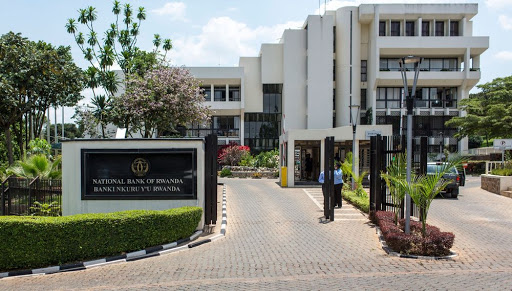
The National Bank of Rwanda(BNR)
The National Bank of Rwanda (BNR)’s statutory quarterly Monetary Policy Committee (MPC) met yesterday, 12th May, to read the runes on economic prospects, as the country, and the world, struggles to emerge from the dire effects of the Coronavirus pandemic on the global economy.
The MPC’s statement could be summed up as, the outlook remains challenging, but all things considered, thanks to timely interventions, there is much reason for optimism for the recovery of the economy.
The big headline figure is that since inflation is projected to remain below 5 percent over the next four quarters, the Central Bank Rate (CBR), the rate at which the central bank lends to the banking sector, will be maintained at 4.5 percent for Rwanda.
Keeping the lending rate as low as inflation and other considerations will allow, is intended to support the banking sector, through which the economic recovery is financed.
As measures to contain the pandemic sent the world economy plunging into what according to the International Monetary Fund (IMF), has been the worst recession since the 1940s following the second World War, Rwanda experienced its first recession since 1994.
This picture is beginning to change in 2021. The IMF projects global economy growing by 6 percent, from a contraction of 3.3 percent, last year.
But uncertainty continues due to delayed Covid-19 vaccine roll out, new variants of the virus, and differences in growth from country to country.
And different factors, including effectiveness of policy support, and conditions in the economy before the crisis hit, continue to contribute to market uncertainties.
Although still feeling the ill effects of the pandemic on the economy, the green shoots of recovery in the domestic are growing strong.
Thanks to support from sound economic policies, from a contraction in the Real GDP (Gross Domestic Product) of 3.4 percent in 2020, the Rwanda economy begun to recover gradually, recording growth in the third quarter of 2020.
This recovery is expected to continue throughout this year, with Real GDP rebounding to 5.1 percent.
It is steady as you go in the foreign exchange market. While the Rwanda Franc depreciated by 5.4 percent against the dollar, last year, as of end of April this year, it had depreciated by 0.993 percent. A slight change from 0.996 at the same period last year.
With the central bank holding foreign exchange reserves for more than four months’ worth of expected imports, the foreign exchange market is expected to maintain its stability.
Overall headline inflation is projected at 2.2 percent this year, down from a high of 5.1 in the fourth quarter of last year.
The agricultural sector, still the main driver of the economy, performed well. Weather conditions, and continued government support to improve agricultural methods, including provision of fertilisers, were some of the contributary factors to the relatively strong performance, despite the Covid-19 crisis.
The rise in both oil and other commodity prices were also a contributor to the high performance of the agricultural sector. Although as a net importer of oil products, Rwanda will have registered some reductions due to the rise in oil prices, but overall, higher commodity prices worked in the country’s favour.
Manufacturing and trade are expected to show good recovery this year, but little change is expected in tourism, which will remain slow, as Covid-19 continues to restrict travel around the world.
The Financial Stability Committee (FSC) held its quarterly meeting earlier, on 10th May. This committee’s assessment was that the sector remained sound and stable, with adequate capital and liquidity.
This again, owed largely to regulatory reforms within the sectors, and favourable macroeconomic conditions in place before the pandemic, added to measures taken to strengthen the sector against the impact of the pandemic.
In fact, in many instances, the sector performed better than last year. Total assets last year grew by 14.5 percent, while as of March this year, they grew by 22.5 percent.
Overall performance of the financial sector is largely driven by the banking, which continues to dominate the financial sector overall, with 67.4 percent of the total assets.
The microfinance and insurance sectors also registered better performances this year, compared to last. Public pension total assets increased 22 percent, to FRW 1,117 billion, with private pensions growing by 29 percent to FRW 60.4 billion.
Although it the effect of the pandemic on the Rwandan economy has been profound, threatening the gains of the last few years, especially poverty reduction, the damage could have cut even deeper, but for timely interventions.
Such interventions were important factors to the eventual recovery. The world’s scientists have warned that the world is likely to face other pandemics similar, or perhaps even more severe than Covid-19.
We do not know, if the Central Bank Governor, John Rwangombwa is a tennis player. If he is, he will surely have cast his mind back to the importance of early preparation in the game, to avoid being “crowded by the ball.”
Responding to a question on lessons learned for Rwanda in the last year, the Governor, pointed to early preparation, and timely response.
“I think one [lesson] that is key to Rwanda…is doing things ahead of time. For example, when Covid hit China, before it even came to Africa, we started following up the impact on the economy. What does it mean? How do we address it, what measures do we need take to deal with this? I think that proactive way of doing things was key in mitigating the impact of the crisis.”
“And then coordinating, and collaborating between the different actors in the economy, or in economic management in general…As usual in economic management numbers are key. For example, we normally tracked the Composite Index of Economic Activity quarterly. When the crisis hit, we moved to tracking it on a weekly basis. We needed to understand what was happening in the economy on a weekly basis. That would help to take decisions that would mitigate challenges here and there…”

